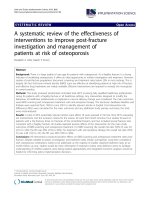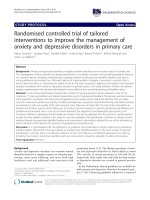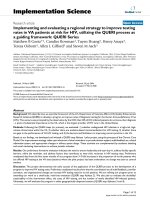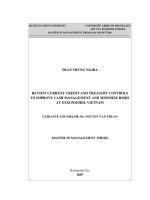Review current credit and treasury controls to improve cash management and minimize risks at exxonmobil Vietnam
Bạn đang xem bản rút gọn của tài liệu. Xem và tải ngay bản đầy đủ của tài liệu tại đây (692.84 KB, 150 trang )
HCMCITY OPEN UNIVERSITY UNIVERSITEÙ LIBRE DE BRUXELLES
SOLVAY BUSINESS SCHOOL
MASTER IN MANAGEMENT PROGRAM (MMVCFB6)
TRAN TRUNG NGHIA
REVIEW CURRENT CREDIT AND TREASURY CONTROLS
TO IMPROVE CASH MANAGEMENT AND MINIMIZE RISKS
AT EXXONMOBIL VIETNAM
GUIDANCE COUNSELOR: Dr. NGUYEN VAN THUAN
MASTER IN MANAGEMENT THESIS
Hochiminh City
2007
WARRANT STATEMENT
This is my original work. All data, results or quotes in the thesis are completely
true.
TRAN TRUNG NGHIA
COMMENTS FROM THE THESIS TUTOR
Student: TRAN TRUNG NGHIA
Thesis: REVIEW CURRENT CREDIT AND TREASURY CONTROLS TO
IMPROVE CASH MANAGEMENT AND MINIMIZE RISKS AT
EXXONMOBIL VIETNAM
Tutor: Doctor NGUYEN VAN THUAN
I suggest the committee should give permission for the author to present the thesis
to your kind perusal and consideration.
Ho Chi Minh City, March 21
st
2007
Dr. NGUYEN VAN THUAN
i
TABLE OF CONTENTS
Acknowledgements
Comments
List of figures
List of tables
List of Abbreviations
Introduction
1. Problem statement
2. Objectives of research study
3. Scope and limitation study
4. Study method
5. Structure of the study
Chapter 1: Literature review 1
1.1 Treasury 1
1.1.1 Definition of cash 1
1.1.2 Definition of cash management 1
1.1.3 Reason for holding cash 3
1.1.4 Determine the target cash balance 4
1.2 Credit 5
1.2.1 Definition of credit 5
1.2.2 Term of sales 6
1.2.2.1 Credit period 7
1.2.2.2 Cash discounts 8
1.2.3 Credit analysis 9
1.2.3.1 Credit Information 9
ii
1.2.3.2 Credit scoring 10
1.2.3.3 The decision to grant credit 10
1.2.4 How to finance trade credit 11
Summary of chapter 1 12
Chapter 2: An overview about Exxon Mobil
corporation in the world and in Vietnam 13
2.1 Exxonmobil (global) 13
2.2 Exxon mobil Vietnam 20
Summary of chapter 2 26
Chapter 3: Current treasury controls
and solutions to improve cash management 27
3.1 Current treasury controls at emvcl 27
3.1.1 Foreign exchange transaction 29
3.1.1.1 Local Environment 29
3.1.1.2 Policy and principles 30
a. General purpose 30
b. Foreign Exchange Strategies 31
c. Speculation 32
d. General 32
3.1.1.3 Authority and controls 33
3.1.1.4 Procedures 34
3.1.2 Bank transfer 35
3.1.2.1 Cash collection 35
3.1.2.2 Internal transfer 36
3.1.2.3 Payment processing 37
a. Payment term application 37
iii
b. Custody and deliver of bank transfer 39
c. Payment recording 39
3.1.3 Loan 39
3.1.4 Working capital analysis 40
3.1.4.1 Cash 41
3.1.4.2 Accounts receivable 41
3.1.4.3 Inventories 42
3.2 Cash management solution 42
3.2.1 Electronic banking system 43
3.2.2 Efficient Fund transfer system 44
3.2.3 Key benefits of electronic banking system 45
3.2.3.1 Db-fast collect (electronic collections) 46
3.2.3.2 Db-fund transfer (Electronic payment) 49
3.3.4 Drawdown in USD or VND 52
3.3.5 Financial budgeting for year 2007 54
3.3.5.1 Cash inflows 55
3.3.5.2: Cash outflows 56
Summary of chapter 3 58
Chapter 4: Current credit controls
and solutions to reduce risks when granting credit limit 59
4.1 Emvcl’s current credit policies and controls 59
4.1.1 Overview about policy and process 59
4.1.2 Roles and Responsibilities of people concerned 60
4.1.3 Use of credit 62
4.1.4 Customer risk revaluation 63
4.1.4.1 Basic process and considerations 63
iv
4.1.4.2 Documentation of risk evaluation 64
4.1.4.3 Small initial deliveries 65
4.1.4.4 Larger exposures 66
4.1.4.5 Separate processes between
customer risk evaluation and granting credit 66
4.1.4.6 Identification and risk monitoring 67
4.1.5 Customer credit decision 68
4.1.5.1 Basic process and considerations 68
4.1.5.2 Exposure limits 69
4.1.5.3 Ongoing customer reviews 74
4.1.5.4 Security 75
4.1.5.5 Credit Approval Limit 76
4.1.5.6 Reductions in credit limits 77
4.1.5.7 Loans and product advances 78
4.1.5.8 High Level Alarm 79
4.1.5.9 Overdue limits 79
4.1.5.10 Common customers across LOBs 80
4.1.5.11 Other 80
4.1.6 Controlling exposure 80
4.1.6.1 Reaching the Credit Limit 81
4.1.6.2 Procedure of block order release 82
a. Overdue orders 82
b. Excessive Credit Limit 85
4.1.7 Invoicing and payment term 85
4.1.7.1 Monetary limits of authority for 2006 86
4.1.7.2 Standard Payment term 87
v
4.1.7.3 Deviations from standard terms 88
4.1.8 Collection 89
4.1.9 Risk monitoring 90
4.1.10 Problem on collecting and bad debt 92
4.1.10.1 Working capital 94
4.1.10.2 Bad debt expense 96
4.1.11 Customer analysis 96
4.2 Solution to reduce risk 98
4.2.1 Effective credit assessment process 98
4.2.1.1: Lines of Business 98
4.2.1.2 Credit group 98
4.2.1.3 Customer Service 99
4.2.2 Customer Risk Assessment Model 99
4.2.2.1 Qualitative information 99
4.2.2.1.1 Year in business 100
4.2.2.1.2 Year Exxon customer 100
4.2.2.1.3 Quality of shareholders 100
4.2.2.1.4 Quality of management 101
4.2.2.1.5 Legal form 101
4.2.2.1.6 Competitive position 101
4.2.2.1.7 Vulnerability to market changes 102
4.2.2.1.8 Exxon-customer supply relationship 102
4.2.2.1.9 Business Integrity 103
4.2.2.1.10 Quality of Operations 103
4.2.2.1.11 Suppliers and Buyers 103
4.2.2.1.12 Payment performance 104
vi
4.2.2.2 Financial strength 105
4.2.2.2.1 Networth 106
4.2.2.2.2 Profitability 106
4.2.2.2.3 Interest cover 107
4.2.2.2.4 Gearing 107
4.2.2.2.5 Current ratio 108
4.2.2.3 Final assessment 108
4.2.3 Distributor finance 109
4.2.3.1 Spreading the statements 110
4.2.3.2 Calculate common size percentages 111
4.2.3.3 Calculate key relationships 112
4.2.3.3.1 Liquidity 112
4.2.3.3.2 Safety 113
4.2.3.3.3 Profitability 114
4.2.3.3.4 Operating performance 117
4.2.3.4 Analysis cash flow 122
4.2.3.5 Compare to trends and industry averages 123
4.2.3.6 Identify problems 123
4.2.3.7 Determine solutions 123
4.2.4 Goods distribution 123
4.2.5 High risk customers 124
4.2.6 Unacceptable terms 124
Summary of chapter 4 125
Conclusions 126
LIST OF FIGURES
Figure Content Page
1 The Baumol model (Cost of holding cash) 5
2 Trade credit 7
3 The cash flows of granting credit 7
4 ExxonMobil’s upstream activities 14
5 ExxonMobil’s upstream activities 14
6 ExxonMobil’s downstream activities 15
7 ExxonMobil’s downstream activities 16
8 ExxonMobil’s chemical activities 17
9 Exxon trademark 18
10 Mobil trademark 18
11 Esso trademark 18
12 Functional map 24
13 Business service chart 25
14 Flowchart of Exxon Mobil treasury procedure 27
15 Local collection process 47
16 Local payment process 50
17 Historical steps 110
LIST OF TABLES
Table Content Page
1 Performance data 19
2 Daily cash analysis report: 29
3
Summary of EMVCL’ balance sheet as of 31 December
2006
40
4 Summary of income statement for year 2005, 2006 40
5 Account receivables in details 41
6 Inventories in details 42
7 VND/USD exchange rate statistic 52
8
Example for USD is more expensive than VND when
VND/ USD exchange rate is rising
54
9 Sale based terms of 2006 (US$ 1,000) 55
10 Sales forecasting for Year 2007 (US$ 1,000) 55
11 Payable forecasting for year 2007 (US$ 1,000) 56
12 Cash flows for year 2007 56
13 Time to review 75
14 Credit approval limits 77
15 Procedures for releasing orders in case of overdue debts 83
16 Risk category at the end of year 2006 96
17
Exposure per risk category at the end of year 2006
(US$ 1,000)
97
18 Terms applied for each line of business 97
19 Score on risk category 99
20 Score on year in business 100
21 Score on relationship with EMVCL 100
22 Score on quality of shareholders 101
23 Score on quality of management 101
24 Score on type of company 101
25 Score on competitive position 102
26 Score on sensitive to market changes 102
27 Score on level of supply 102
28 Score on integrity 103
29 Score on quality of operation 103
30 Score on business stability 104
31 Score on payment history last 12 months 104
32 Score on payment history last 6 months 104
33 Score on payment improvement 105
34 Score on overdue 105
35 Standard scores for risks 106
36 Risk category on networth 106
37 Risk category on profitability 107
38 Risk category on interest cover 107
39 Risk category on gearing 107
40 Risk category on current ratio 108
41 Risk category of company 108
42 Payback period 108
LIST OF ABBREVIATIONS
Abbreviation Content
AP Accounts Payable
AR Accounts Receivable
BAR Business Analysis Reporting
BD-direct Debit-direct
BG Bank Guarantee
BIDV Bank for Investment and Development of Vietnam
BKK Bangkok Payable Manager
BOM Board of Management
BRs Banking Resolutions
BSM Business Service Manager
COD Cash on Delivery
COR Cash on Receipt
CS Customer Service
DCP Delegated Cash Process
DES Daily expenses statement
DOAG Delegation of Authority Guideline
DSO Month-end days sales outstanding
EAB Eastern Asia Commercial Bank
EBIT Earning before Interest and Tax
EM ExxonMobil
EMVCL ExxonMobil Vietnam Company Limited
ERP Enterprise Resources Planning
FX Foreign Exchange
GD General Director
GL General ledger
HCMC Ho Chi Minh City
HN Ha Noi
ICB Industrial and Commercial Bank of Vietnam
L/C Letter of Credit
LOB line of Business
LOI Letters of Instructions
P/(L) Profit and Loss
PO Purchase Order
SBV State Bank of Vietnam
Abbreviation Content
TAR Total Accounts Receivable
U.S United State
VBA Bank for Agriculture and Rural Development of Vietnam
VCB Vietcombank - Bank for Foreign Trade of Vietnam
VMF Vendor Master File
WTO World trade organization
ACKNOWLEDGEMENTS
Firstly, I would like to show my deep gratitude to Professors, Universiteù Libre de
Bruxelles, Solvay Business School and Hochiminh City Open University for
providing very sophisticated lessons and giving valuable experience during my
study.
I wish to give my special thanks to my Tutor, Dr. Nguyen Van Thuan, for his
enthusiastic and valuable guidance, advices and encouragement throughout my
thesis.
Many appreciation and thanks are also extended to my colleagues, classmates,
program co-ordinators, ExxonMobil Vietnam and my family for their supports
and encouragements during the program.
Ho Chi Minh City, 17 March 2007
Tran Trung Nghia
INTRODUCTION
1. PROBLEM STATEMENT.
Vietnam has been a member of WTO, a very important jumping step in
economic development process. It is a bright signal for everyone as well as
enterprises. However, The fierce competition from the global economy is not
easy at all. The companies having grown up and are developing as well as many
having just been born are facing with a lot of difficulties and challenges from the
result of this integration process. In front of those difficulties and challenges, all
companies must find out the way to go a head. One of the basic ways to exist is
to improve the internal controls, of which financial controls is really very
necessary.
Treasury and Credit are not much mentioned in Vietnamese companies. They
only show up at the big corporations.
Treasury activities are related to cash, payment, banking, which is very sensitive
in business. All companies, either small or large, have to pay or receive cash.
They have to use the banking services or facilities to meet the very basic need.
Therefore, with the effective treasury activities and valid payment procedures,
the company will be able to minimize cost, maximize profit, reduce risks, create
more value and trustworthy from suppliers.
Nowadays, due to competition, all most companies do not sell products or
services in cash but by deferred payment. Therefore, setting up the payment
conditions and methods complied with the company’s financial ability is not easy.
With a good credit policy and controls, the company will get more profit and
avoid the risks.
ExxonMobil is a huge company in the world specializing in oil and gas
production. It has attended everywhere. ExxonMobil has been and is very
successful in the world and in Vietnam market thanks to the super quality lines of
product and its very successful controls. Working for ExxonMobil Vietnam, I
have a lot of opportunities to learn a lot about financial management, processes
and effective procedures. On the occasion of completing my Master program, I
would like to choose the Treasury and Credit subject for my thesis.
2. OBJECTIVES OF RESEARCH STUDY.
The objectives of the research study are described as follows.
Firstly, The study will state the importance of Treasury and Credit management
in the big companies and introduce effective controlling processes, procedures,
models in cash and credit controls.
Secondly, This research will help us review the Credit and Treasury to improve
the cash management as well as reduce risks when granting credit lines to
distributors.
Finally, We will give some recommendations and ideas for improving cash
management and reducing credit risks for the next years.
3. SCOPE AND LIMITATION OF RESEARCH STUDY.
This research will concentrate on the Treasury and Credit management at
ExxonMobil Vietnam.
It will focus on introducing about the ExxonMobil Global and Vietnam,
processes, procedures, models applied at ExxonMobil Vietnam.
We also give some ideas and recommendations on current Treasury and Credit
controls and for improvement in the future.
4. STUDY METHOD.
Desk research
Information and data in this thesis is gathered from the global company website
(empa.ap.xom.com), other local websites, company reports, global company
magazines, local newspapers, my managers and colleagues.
Analysis, assessment and supplement
Base on the available information and data collected, we focus on analyzing
explaining, giving assessments and supplements.
5. STRUCTURE OF THE STUDY.
Introduction
Chapter 1 Literature review
Chapter 2 An overview about ExxonMobil corporation in the world and in
Vietnam
Chapter 3 Current treasury controls and solutions to improve cash management
Chapter 4 current credit controls and solutions to reduce risks when granting
credit limit
Conclusions
1
CHAPTER 1.
LITERATURE REVIEW
1.1 TREASURY
1.1.1 Definition of cash
1
:
The term cash is surprisingly imprecise concept. The economic definition of cash
includes currency, checking account deposits at commercial banks, and un-
deposited checks. However, financial managers often use the term cash to
include short-term marketable securities. Short-term marketable securities are
frequently referred to as “cash equivalents”, treasury bills, certificates of deposit
and purchase agreements.
1.1.2 Definition of cash management
1
:
Cash management is balance the cash collection and disbursement, i.e.
determining the appropriate target cash balance, collecting and disbursing cash
effectively and investing excess cash in marketable securities:
Determining the appropriate target cash balance involves an assessment of the
trade off the benefit and the cost of liquidity. The benefit of holding cash is the
convenience in the liquidity it gives the firm. The cost of holding cash is the
interest income that the firm should have received from investing in the treasury
bills and other marketable securities. If the firm has achieved its target cash
balance, the value it gets form the liquidity provided by its cash will be exactly
equal to the value forgone in interest on an equivalent holding securities. In
other words, the firm should its holding of cash until the net present value from
1
Stephen A. Ross, Randolph W. Westerfield, Jeffrey Jaffe, Corporate Finance
2
doing so is zero. The incremental liquidity value of cash should decline as more
of it is held.
After the optimal amount of liquidity is determining, the firm must establish
procedures so that cash is collected and disbursed as efficiently as possible. This
usually limit circumstance of collect early and pay late.
The companies must invest temporary idle cash in short-term marketable
securities which are not popular in Vietnam.
The basic objective in cash management is to keep the investment in cash as low
as possible while still operating the firm’s activities efficiently and effectively.
The challenges of cash management are:
- How to minimize cost
- How to maximize profit
- How to control cash flow
- How to manage risk
- How to employ technology
- How to create value.
Almost the Vietnamese companies manage their cash as traditional way, they
manage as actual requests, without strategy or cash flow forecast. This leads to
many risks, waste of money, un-liquidity.
3
1.1.3 Reason for holding cash:
There are two primary reasons for holding cash.
Firstly, cash is needed to satisfy the transaction motive. Transaction-related
needs come from normal disbursement and collecting activities of the company.
The disbursement of cash includes the payment of wage, salary, trade debts,
taxes, dividends. Cash is collected from sales from operations, sales of assets,
and new financing. The cash inflows and cash outflows are not perfectly
synchronized, and some level of cash holdings is necessary to serve as a buffer.
If the company maintains too small cash balance, it may run out of cash. If so, it
must sell marketable securities or borrow. Selling marketable securities and
borrowing involve trading costs.
Another reason to hold cash is for compensating balances. Cash balances are
kept at commercial banks to compensate for banking services rendered to the
company. A minimum required compensating balance at banks providing credit
services to the company may impose a lower limit on the level of cash the
company holds.
The cash balance for most companies can be thought of as consisting of
transaction balances and compensating balances. However, it would not be
correct for the company to add the amount of cash required to satisfy its
transaction needs to the amount of cash needed to satisfy its compensatory
balances to produce a target cash balance. The same cash can be used to satisfy
both requirements.
4
The cost of holding cash is, of course, the opportunity cost of lost interest. To the
determine the target cash balance, the company must weigh the benefit of
holding cash against the cost. It is generally a good idea for the companies to
figure out first how much cash to hold to satisfy the transaction needs. Next, the
company must consider compensating-balance requirement, which will impose a
lower limit on the level of the company’s cash holdings. Because compensating
balances merely provide a lower limit, we shall ignore compensating balances
for the following discussion of the target cash balance.
1.1.4 Determine the target cash balance:
The target cash balance involves the trade-off cost between the opportunity costs
of holding too much cash and the trading costs of holding cash too little. If the
company tries to keep its cash holdings too low, it will find itself selling
marketable securities (and, of course, buying marketable securities to replace
those sold) more frequently than if the cash balance was higher. Thus, trading
costs will tend to fall as the cash balance becomes larger. In contrast, the
opportunity costs of holding cash rise as the cash holdings rise.
5
Figure 1: The Baumol model (Cost of holding cash)
2
1.2 CREDIT
1.2.1 Definition of credit
1
:
When the firm sells goods and services, it can be paid in cash immediately or
wait for a time to be paid, that is, extend credit to customers. Grading credit is
investing in a customer, an investment tied to the sale of a product or service.
An account receivable is created when credit is granted. These receivables
include credit granted to other firms, called trade credit, and credit granted
customers, called consumer credit.
2
W.S. Baumol, “The transactions Demand for Cash: An Inventory Theoretic Approach.” Quarterly
Journal of economics 66 (November 1952)
Opportunity costs
C
Cost of holding
cash
Total cost of holding cash
Trading costs
Size of cash balance (C)
Optimal size of cash balance
(Target balance)
- Trading costs are increased when the company
must sell securities to establish a cash balance.
- Opportunity costs are increased when there is a
cash balance because there no return cash









